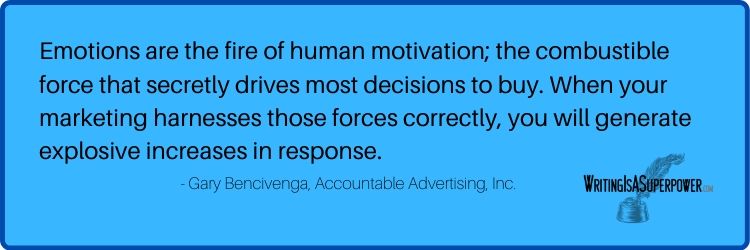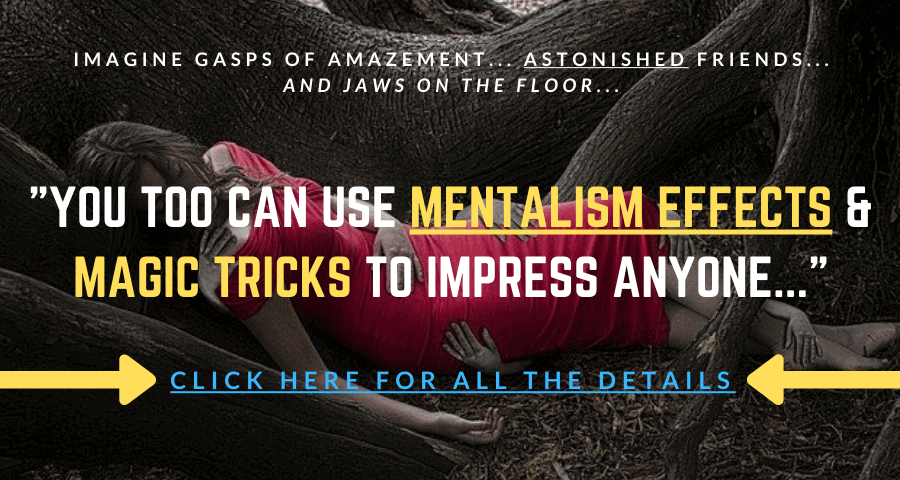
The mechanics of copywriting are simple and easily grasped by anyone capable of writing a complete sentence.
The biggest challenge most copywriters face isn’t the mechanics of the craft, but understanding the target audience and how the product can help them.
This Free Copywriting Course will show you everything you need to know to get started and how to continue to grow as a copywriter.
Free Copywriting Course, Part 2.
At the moment, you are on Part 2 of the Free Copywriting Course.
In Part 1 of the Free Copywriting Course, you discovered how to use power words to electrify your writing, how good copy seduces the prospect into buying, and how to tap into the dreams and desires of the target audience.
Hopefully, you also started a copywriting notebook to record power words and phrases you discover in sales pages and videos.
In this part of the course, Part 2, you will learn the following:
- How to Inject Emotions into Your Copy.
- How to Show and Not Tell.
- How to Create a Customer Persona.
- How to Plan a Copywriting Project.
- How to Write a Killer Call to Action.
Remember, because each lesson builds on the previous one, it’s essential to complete them in order.
Complete Part 1 First.
Before you begin Part 2 of the Free Copywriting Course, please first compete Part 1, read the recommended sales pages and watch the recommended sales videos.
I chose these sales pages and videos because they will help you internalize the fundamentals of copywriting more easily.
The sooner you can get this under your belt, the sooner you’ll be earning a respectable income writing copy.
If you have read through part one and studied the suggested sales letters, you’re ready to begin Part 2. We start with how important emotions are to the sales process.
Emotions are Key.
We humans are an interesting lot, particularly when we buy things. Rarely do we buy something because we need it. Instead, we typically purchase things we want.
It’s a subconscious drive to have more and to be more.
The truth is, we need little beyond food and shelter, but that doesn’t stop us from purchasing a new car when a used car would get us around for a fraction of the cost.
Our subconscious drives us to have more and be more.
It’s why we buy bigger houses, evermore dazzling cosmetics, beautiful clothes that change style with insane regularity, and expensive electronic gadgets that brush our teeth and sing us to sleep.
Of course, we don’t need any of it. We want it.
We buy things because they appeal to our subconscious desire to be more attractive and to have higher social status.
Copy that appeals only to the prospect’s rational mind will NOT succeed. It will only die a quiet death and leave the copywriter scratching her head in bewilderment.
Copy targets a specific emotion does much better because it makes the target audience feel something.
It might be greed, curiosity, sloth, lust, vanity, trust, anger, or fear, but the prospect must feel something, or they won’t follow through with the Call to Action.

How to Inject Emotion into Your Copy.
Now that you know how important it is to create an emotional response in your target audience, how do you do it?
Start with deciding what emotion you want your prospect to feel. Pick only one.
The emotion you want the prospect to feel is dependent on the product or service you’re pitching. If you’re selling investments, you may want to trigger greed or trust in the prospect.
If you’re pitching a dating service, you might choose to inspire lust in the target audience.
Imagine you’re writing copy to promote a term life insurance product. You might want the prospect to experience the unsettling possibility of dying and leaving their loved ones to live in poverty.
Fear primes the target audience to accept your sales message. You could write something like, “If you aren’t there, who would take care of your family?”
Once you decide how you want your target audience to feel, you can structure your copy to create that emotional experience for them.
If you wanted your prospect to feel curious about your offer, you might start your copy with a question that includes a curiosity provoking power word.
For example, if you’re promoting a weight loss product, you can ask, “Did you know that off the record, most doctors admit they can’t lose weight either?”
By using various openings, formats, and styles, you can inspire an emotional response in your target audience.
How to Hit Their Emotional Buttons.
The trick to hitting the prospect’s emotional buttons and capturing their attention is to be helpful. That’s right.
Be helpful.
In Part 1 of the Free Copywriting Course, we learned it was essential to love your target audience.
This attitude will pay dividends throughout your copy and naturally puts you in the mindset to be helpful.
It begins by finding out what problems your target audience is struggling with or what they want more of.
Then, as you write your copy, focus on how you can help them solve their problem or get more of what they want.
As you write, keep asking yourself, “how can you help the prospect,” and you will naturally write engaging copy that holds their attention and touches them emotionally.
This approach will significantly increase the persuasive power of anything you write, such as sales copy, emails, reports, or blog posts.
Making your prospects feel something is essential to persuasive copy. When you infuse your copy with emotional cues, it comes alive in the mind of your target audience.

Real World Copy: Emotions
To help you conceptualize how copy appeals to our emotions, visit the sales page listed below by clicking on the link.
The product is Total Money Magnetism, said to help you attract and keep more money. By using strategic words and phrases, the video appeals to your subconscious desire to be more and have more.
For example, near the beginning of the video, Total Money Magnetism promises to show you how you can, “Enjoy the absolute best life has to offer every single day!”
That’s powerful! You’ll find more copywriting gems in the video too. Remember to bookmark this video for future reference.
Watch the Total Money Magnetism video and note when the sales message appeals to your desire to be more and have more. Also, note the power of story and how the video makes you feel.
Because each lesson builds on the previous one, it’s essential to watch the video now.
Click here to visit the sales page for this lesson: Total Money Magnetism.
(Or, go to WritingisaSuperpower.com/TotalMoneyMagnetism)
Show Don’t Tell.
Do you laugh when someone TELLS you they’re funny? Of course not.
You laugh when they SHOW you how funny they are.
People don’t buy because you tell them your product is the best. They buy when you SHOW them it’s the best.
“Show don’t tell” makes every form of writing better.
If you tell your target audience about your product, you put them to sleep. When you SHOW them, they sit up and take notice.
You see, telling doesn’t capture anyone’s attention. Telling tends to bounce off our awareness life a piece of dryer lint.
However, when you paint word pictures, your sales message gets in the prospect’s head. And, as a copywriter, that’s an excellent place to be.
When you paint word pictures with your copy, the prospect begins to see the product in their life.
Word pictures add to the prospect’s emotional experience, too, creating a multi-dimensional experience for them.
Showing instead of telling will require that you write more words. That’s okay. Paint word pictures with short sentences, and the target audience will follow every word you write.
The following banner ad for a mentalism and magic product opens with “Imagine…” and then quickly paints a word picture of you astonishing your friends.
It’s a powerful image.
Real World Copy: Show Don’t Tell
To help you conceptualize the importance of painting word pictures for your target audience, visit the sales page listed below by clicking on the link.
The product is Master Mentalism & Magic Tricks! This inexpensive training promises to show you an easy and entertaining way to impress anyone.
As you read the sales page, notice how the copy repeatedly paints word pictures of you entertaining and astonishing your friends.
Pick out the power words phrases and add them to the copywriting notebook you started in Part 1 of the Free Copywriting Course.
You’ll find some real power word gems in this sales letter, such as “stunningly explosive” and “extremely sensitive.”
What emotions are associated with the power words you find?
Read the entire Master Mentalism & Magic Tricks sales page and bookmark it for future reference.
Because each lesson builds on the previous one, it’s essential to read the sales page now.
Click here to visit the sales page for this lesson: Master Mentalism & Magic Tricks!
(Or go to WritingisaSuperpower.com/MasterMentalism)
The Essential Customer Persona.
As a copywriter, you must focus your copy on a specific target audience, those people who would benefit from your product, and who have the resources to purchase it.
Also, you can’t write effectively to a crowd. You must write to an individual.
Creating a customer persona or profile helps you tailor your copy to the ideal prospect. It also helps you during the writing process to address a specific individual instead of a nebulous crowd.
A customer persona, or profile, is a fictional representation of your ideal customer.
For example, if you are selling high-end baby strollers, your ideal customer would be young professionals who are either planning a family or who have a newborn.
These parameters indicate that most of your customers would be approximately 25 to 40, with an annual income of $75k or higher.
While both a mother and father might be interested in high-end baby strollers, we will choose to focus on the mother because she is more invested in the birth process.
With just this little bit of information about our ideal customer, we begin to see an image of her.
These general demographics about your ideal customer are helpful, but as a copywriter, you must dig deeper.
Let’s start by giving her a name. Call her April.
To help make her as real in our minds as possible, we’ll find a representative image of her online, print it out, and place it where we can see her as we write.
When we write our copy, we are writing to April.

Before we begin, we need to know April’s challenges and pain points. What keeps her awake at night? What are her ambitions and aspirations?
Finding this information will help you better understand what motivates April to choose your baby stroller over the competition.
Our goal is to understand April so well we can empathize with her problems, fears, and desires. And, then, sincerely offer a solution that helps her.
Here are three ways to learn more about Alice.
- Social Media (Facebook, Twitter, YouTube, Instagram, WhatsApp, LinkedIn, Pinterest, Reddit, etc.)
- Review Sites (Amazon, Yelp, Google My Business).
- Ask people (Friends, colleagues, salespeople, existing customers).
- Company resources (product surveys, letters from customers, previous marketing campaigns).
Social Media.
Because people use social media to voice their frustrations or to show off their accomplishments and trade information, social media is a window into the mind of your customer.
It can be a goldmine of information.
Search for keywords or hashtags related to your product, and you’ll find a wealth of material you can use. What are people saying about your product or the product of your competitor?
What do they like about it or dislike about it? What do they want?
In the case of our fictitious ideal customer, Alice, what are the concerns of young mothers regarding baby strollers?
Why do they buy them? Is their highest concern safety for the baby, comfort, room for baby supplies, or status among young mothers?
YouTube offers many product review videos and videos about specific life issues.
For example, there may be a video about how to buy a high-end baby stroller. Such a video might reveal what young professionals look for when buying a baby stroller.
Review Sites.
Amazon is an excellent place to start if you’re pitching a physical product.
If the product you are pitching is on Amazon, all the better, but if it’s not, read the reviews of your competitor’s product.
Read both positive and negative reviews. They both may have insights you can use.
What do people love about the product? How were they disappointed? Why did they buy it? What problem were they trying to solve?
Ultimately, you’re trying to determine what do the target audience wants and how your product can help them?
This information is extremely useful. It’ll help you build your ideal customer persona and also reveal the issues you must address in your copy.
Also, through social media, you may be able to communicate with customers through the comments and find out more, which brings us to the next source of information.

Talk to People.
Talk to anyone remotely related to your product’s niche. If the product has been available for some time, the sales force will have insights you can use.
If possible, talk to existing customers.
Don’t just shoot from the hip when you speak to people about the product. Be prepared.
Start by becoming an expert on the product, so you know every detail about it and how to use it.
Then, when you speak to a customer, you’ll know how to get the most out of the interview.
Look for patterns between the various comments. Do people have strong feelings about it? Why?
Why did they purchase the product? Look for a problem or issue the customer was attempting to resolve by buying the product.
When you’re polite and interested in learning more, you will naturally gain extraordinary insight into why someone would buy your product.
This insight is invaluable and may form the central theme of your copy.
Company Resources.
Good business practices suggest that before a product or service comes to market, someone has conducted thorough research to determine if there is a need for that product or service.
This research should include a profile of the ideal customer with demographic and psychographic information.
If you are writing for a client, ask for all the information they may have concerning the ideal customer and market research.
Write Like Your Customer Speaks.
While you’re researching your ideal customer, keep notes on the words and phrases that appear to be peculiar to them.
Knowing how your customer speaks and the jargon they use will boost the impact of your copy tremendously. Writing in their style builds trust and helps them see you as part of their group.
Unfamiliar jargon can sound elitist and arrogant. It’s your job, as the copywriter, to communicate with your prospect in a language they find familiar and comfortable.
When you use words and phrases that are unfamiliar to the prospect, the copy draws attention to itself. It breaks the persuasive spell.
You Got to Have a Plan.
Now that you have the fundamentals of copywriting under your belt, you’re almost ready to write copy, but first, you need a plan.
It’s essential to begin each writing project the same way. Knowing how to start prevents procrastination and helps you complete projects faster.
A copywriting plan begins with a crystal-clear goal. What must your copy achieve? What action do you want the target audience to take?
You can’t score if there isn’t a goal. If you want to write copy that converts prospects into customers, you must have a goal before you begin.
A goal keeps you focused, and a simple three-point plan will keep you on track as you write.

The 3-Point Copywriting Plan.
- What do you want your prospect to KNOW?
- What do you want your prospect to FEEL?
- What do you want your prospect to DO?
Keep these three things in mind as you write, and your copy will stray less often. Plus, the process will take much less time.
Editing and polishing will be easier too.
Creating Your Writing Plan.
We’ve seen that a copywriting plan includes what we want the prospect to KNOW, FEEL, and DO.
Create three columns on a piece of paper or document creation software. At the top of the first column, write KNOW.
The second column is FEEL and, you guessed it, DO is the third column.
What do you want your prospect to KNOW?
In the KNOW column, write down the single primary thing you want your prospect to know, the one big take away.
For example, it could be “How to Get Your Ex Back,” or “Creating Wealth,” or “Three Ways to Work from Home.”
It’s essential to focus on only ONE idea. When you pitch more than a single idea, your copy gets complicated. You don’t want that.
Complication confuses the prospect. Confused prospects rarely become customers.
Keep it simple. Keep it focused.
What do you want your prospect to FEEL?
As a copywriter, you want to stir the prospect’s emotions.
In the Feel column, write down the emotion you want to inspire in the prospect. Give this some thought as it will set the tone of the entire writing project.
Remember, people buy for emotional reasons. Before your copy can inspire the prospect to buy, it must touch them emotionally.
Once you decide what you want your target audience to feel, you can structure your copy to stir that emotion.
Stirring emotion in the prospect begins with the headline and opening paragraphs of your copy.
If you want to stir curiosity, begin with a question.
For example, if you’re pitching a Make Money Online or Work From Home product, you might have a headline that reads, “What if you could quit your job tomorrow?”
Doesn’t that make you curious to learn more?
If you want to stir anger, your headline might read, “Are you making your boss rich and getting nowhere?”
Anger is a powerful emotion and can be triggered when you point out something is unfair for the prospect.

What do you want your prospect to DO?
You must tell the prospect what you want them to do. It seems some copywriters forget they are in the selling business and forget to ask for the order.
The Call to Action at the end of your pitch is essential.
What is the one thing you want the prospect to do? Write that down in the third column.
You must be extremely clear with your Call to Action. Tell them to subscribe now, buy now, order now, download now, click now, start now, etc.
Whatever you want them to do, tell them to do it.
Always include a Call to Action (CTA) in every piece of copy you write. In a moment, I’ll show you an ingenious method for writing a killer CTA.
The Copywriting Plan Revisited.
You now know how to create a copywriting plan that will keep you focused and on track as you work.
With this simple plan, you’ll have a clear insight into what you want your prospect to KNOW, FEEL, and DO.
Don’t overthink it. Keep it simple, and keep it crystal clear.
How to Write a Killer Call to Action.
In the Call to Action, you must be assertive. You must tell the prospect what to do and to do it NOW!
- Make the CTA short, simple, and direct. The CTA is a command, not a suggestion.
- Use active language and make it interesting.
- Use power words. You’ll find lists of power words in Part 1 of the Free Copywriting Course.
- Also, by now, I hope you have a growing collection of power words in your copywriting notebook.
- Add a sense of urgency. Hint that the prospect will miss out if they don’t act now.
- Eliminate Risk. Where appropriate use phrases like “Act now, no credit card needed,” “60-Day Money Back Guarantee,” or “Enroll now, cancel anytime.”
Make the CTA as simple, direct, and risk-free as possible.

In Part 2 of the Free Copywriting Course, we’ve covered the following topics.
- How to Inject Emotions into Your Copy.
- How to Show and not Tell.
- How to Create a Customer Persona.
- How to Plan a Copywriting Project.
- How to Write a Killer Call to Action.
The Free Copywriting Course continues with Part 3.
In Part 3, you’ll discover the most useful copywriting formulas and how to write captivating headlines.


